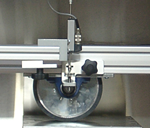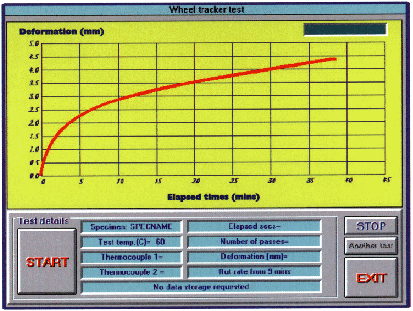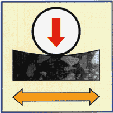SPECIFICATION
The Wheel Tracking test is now included in proposed CEN specifications (Test method number: CEN PrEN 13108/12697-22).
The wheel tracking apparatus shall consist of a loaded wheel which bears on a sample held on a moving table. The table shall reciprocate with simple harmonic motion through a distance of 230 �5mm with a frequency of 42 passes (�1%) per minute.

The wheel shall be fitted with a solid rubber tyre of outside diameter 20Omm. The tyre shall be of rectangular section 5 0 � 1 mm wide and 1Omm to 13 mm thick. The rubber shall have a hardness number of 80 � 5 IRHD units. The wheel load, under standard conditions, shall be 520 � 5 N.
The wheel tracker shall be fitted with a temperature controlled cabinet with a temperature range of 30 C to 60 C � 1 C.
Temperature shall be controlled using a PID controller with feedback from a PRT sensor.
The cabinet shall have double polycarbonate glazed doors to permit full access to the test area. Safety switches shall be fitted to prevent operation of the drive and temperature control systems when the doors are open.
The cabinet shall contain shelves to enable up to six 20cm diameter specimens to be conditioned at the test temperature.

The sample shall be either a 20Omm diameter core or a 305mm square slab of asphaltic mixture from 40mm to 10Omm thick and the wheel tracker table shall be fitted with clamps necessary for securing specimen holders.
The wheel tracker shall be fitted with a 25mm (min) stroke LVDT transducer for monitoring rut depth in the centre of a sample during a test to better than 0. 1 mm.
The wheel tracker interface unit shall be fitted with two thermocouple inputs for optional specimen temperature measurement.
The deformation and sample temperature shall be recorded by an IBM 486DX (or compatible) computer fitted with a data acquisition and control (DAC) board.
The operational software shall run under Windows 3.1 or 95 to start and stop the wheel tracker, control speed and acquire deformation and temperature data via a DAC board and interface unit. An on-screen display shall provide a continuously updated graph of time versus deformation. The test data will be shall be stored in a text file for subsequent analysis and comparison using a spreadsheet. On completion of a test, the option of using a printer to produce a copy of the graphical and tabulated results shall be provided.
The wheel load shall be verified and the deformation transducer calibrated using equipment traceable to National Standards.

The equipment is powered from a normal 230V, 13A supply.
The user should provide a computer and printer. Suitable computers and printers can be supplied if required.